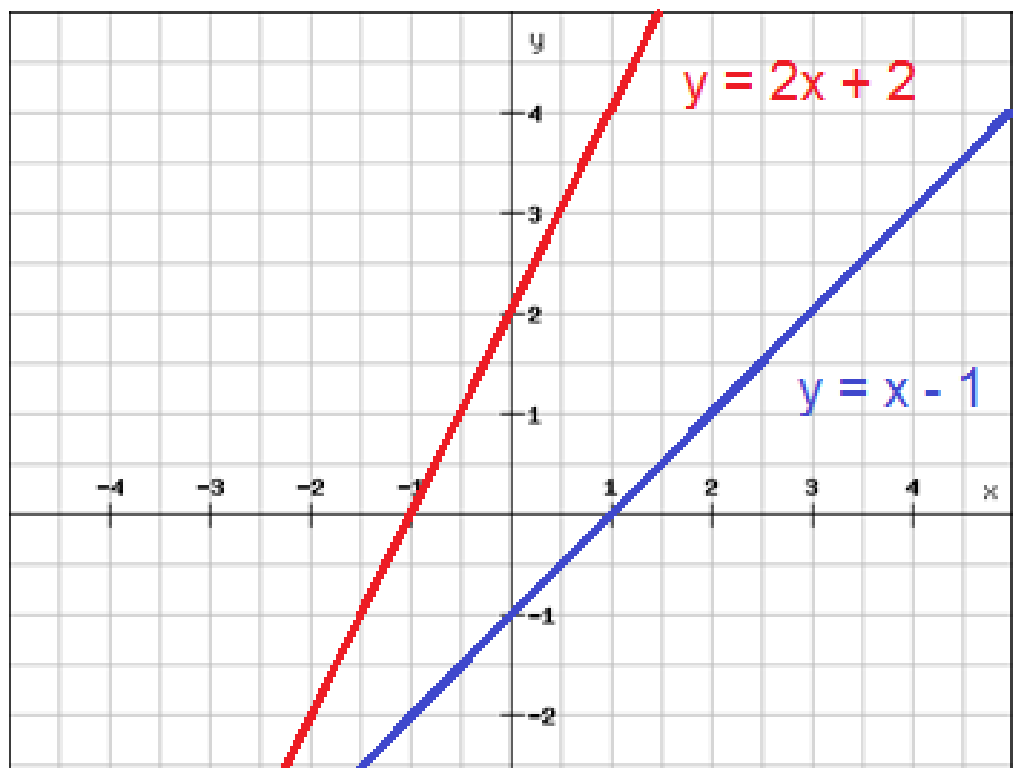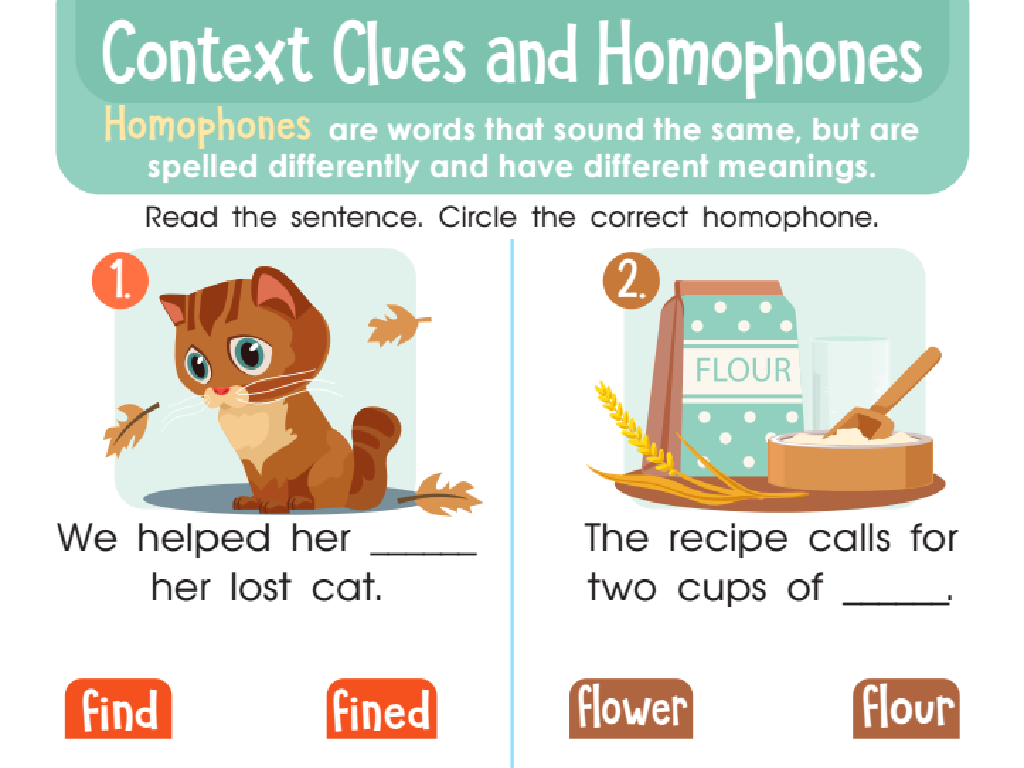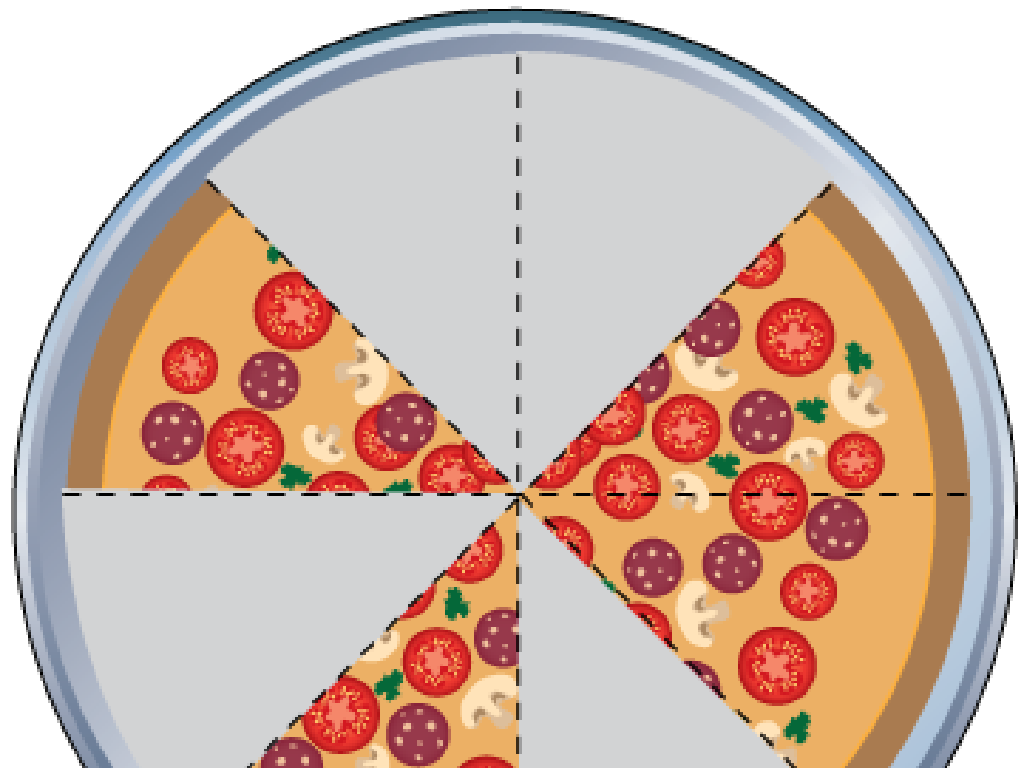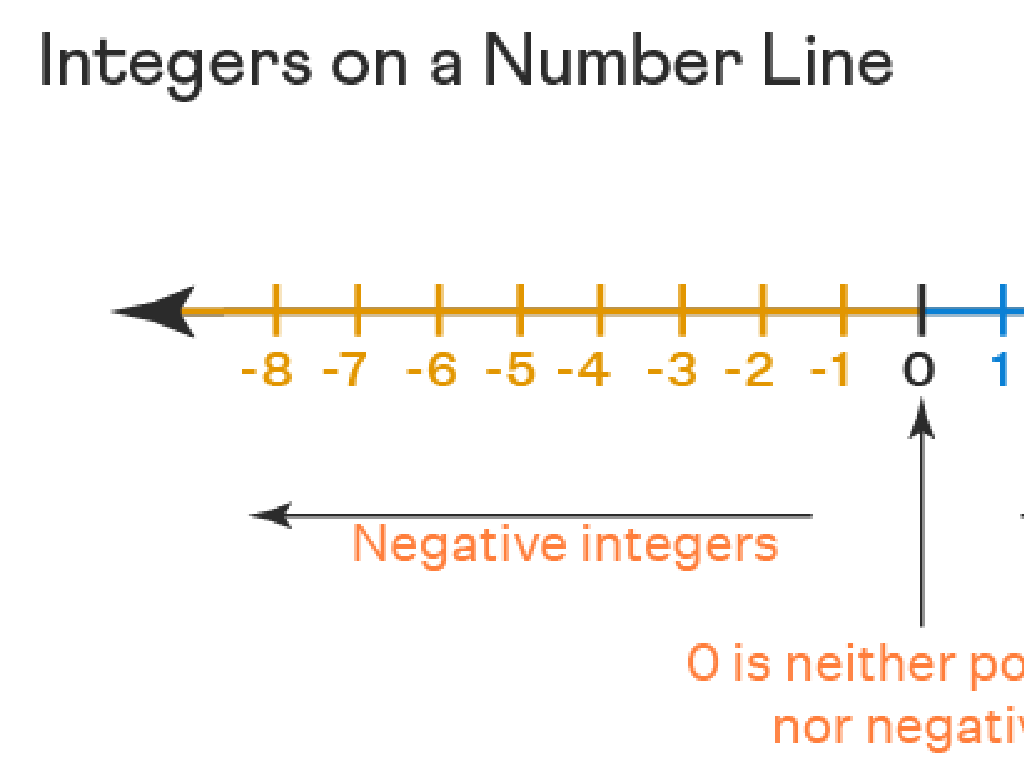Multiply Mixed Numbers: Word Problems
Subject: Math
Grade: Sixth grade
Topic: Multiply Fractions
Please LOG IN to download the presentation. Access is available to registered users only.
View More Content
Multiplying Mixed Numbers via Word Problems
– Grasp mixed number concept
– A mixed number has a whole number and a fraction, e.g., 2 1/3
– Review fraction multiplication
– Recall multiplying fractions: multiply numerators and denominators
– Today’s focus: Multiply mixed numbers
– Use mixed numbers in multiplication to find product
– Solve real-world problems
– Apply what we learn to situations like cooking or building
|
Begin with a clear explanation of mixed numbers, emphasizing the combination of whole numbers and fractions. Review the process of multiplying fractions, ensuring students are comfortable with multiplying numerators and denominators. The main objective is to apply this knowledge to multiply mixed numbers, particularly within the context of word problems. Provide examples that relate to everyday scenarios, such as doubling a recipe or calculating the area of a space, to illustrate the practical use of multiplying mixed numbers. Encourage students to visualize the problems and work through them step-by-step.
Converting Mixed Numbers for Multiplication
– Why convert mixed numbers?
– To multiply, we need improper fractions
– Steps to convert to improper fractions
– Multiply the whole number by the denominator, add the numerator
– Example: Convert 2 1/3
– 2 1/3 becomes 2*3/1 + 1/3 = 7/3
– Practice with different numbers
|
Understanding how to convert mixed numbers to improper fractions is crucial for multiplying fractions effectively. Start by explaining the necessity of this conversion for multiplication. Demonstrate the conversion process step by step: multiply the whole number by the denominator and then add the numerator to this product. Use 2 1/3 as an example to solidify the concept. After explaining, provide students with various mixed numbers to practice converting on their own, ensuring they grasp the method. Encourage them to check their work by converting the improper fraction back to a mixed number.
Multiplying Fractions: A Quick Review
– Review: Multiplying Fractions
– Example: 1/2 x 3/4
– To multiply, simply multiply the numerators and then the denominators.
– Step-by-Step Solution
– Multiply tops (1×3), multiply bottoms (2×4), simplify 3/8 if needed.
– Class Practice Activity
– We’ll solve fraction multiplication problems as a class.
|
Begin with a brief review of the steps to multiply fractions, ensuring students recall the process. Present the example 1/2 multiplied by 3/4, and demonstrate the multiplication of the numerators and denominators separately, followed by simplification. For the class practice activity, provide a set of fraction multiplication problems for students to solve. Encourage collaboration and discussion among students to foster a deeper understanding. As they work, circulate the room to offer guidance and ensure that students are correctly applying the steps to multiply fractions.
Multiplying Mixed Numbers: A Step-by-Step Guide
– Convert to improper fractions
– Change mixed numbers like 2 1/3 to improper fractions like 7/3
– Multiply the numerators
– Multiply the top numbers of the fractions
– Multiply the denominators
– Multiply the bottom numbers of the fractions
– Simplify the resulting fraction
– Reduce the fraction to its simplest form, if possible
|
This slide outlines the process of multiplying mixed numbers for sixth-grade students. Begin by converting any mixed numbers into improper fractions to simplify the multiplication process. Once in improper fraction form, students should multiply the numerators (top numbers) together and then the denominators (bottom numbers) together. After the multiplication, it’s crucial to simplify the fraction to its lowest terms if necessary. This may involve finding the greatest common divisor and dividing both the numerator and denominator by that number. Encourage students to practice these steps with various examples and provide guidance on simplifying fractions.
Multiplying Mixed Numbers: Word Problems
– Comprehend the word problem
– Read carefully to grasp the scenario and what is asked.
– Find the mixed numbers involved
– Look for numbers like 1 3/4 that need to be multiplied.
– Execute multiplication step by step
– Convert to improper fractions, multiply, then simplify.
– Review and verify your solution
– Check if the answer makes sense in the context of the problem.
|
This slide aims to guide students through the process of solving word problems that involve multiplying mixed numbers. Start by understanding the problem, which means reading the problem carefully and identifying what is being asked. Next, identify the mixed numbers that will be multiplied. Teach students to convert mixed numbers to improper fractions before multiplying, and then simplify the result back into a mixed number if necessary. Finally, encourage students to review their solution to ensure it makes sense within the context of the problem. Emphasize the importance of checking work and understanding the real-world application of the math skills they are learning.
Multiplying Mixed Numbers: Word Problems
– Read the problem as a class
– Highlight key information
– Look for numbers, units, and the question
– Convert mixed numbers to improper fractions
– Use the formula: Mixed number = (whole number × denominator) + numerator
– Multiply and simplify for the solution
– Follow the steps: multiply numerators, multiply denominators, then simplify
|
This slide is aimed at teaching students how to approach and solve word problems involving the multiplication of mixed numbers. Start by reading the problem together to ensure understanding. Next, guide students to identify and highlight the important information, such as the mixed numbers to be multiplied. Teach them the process of converting mixed numbers to improper fractions before multiplication. Finally, demonstrate how to multiply the fractions and simplify the result to find the solution. Encourage students to practice these steps with various problems and ensure they understand each part of the process.
Multiplying Mixed Numbers: Practice Problems
– Baking problem: Fraction of ingredients
– If a recipe needs 1 3/4 cups of sugar and you’re making double, how much sugar is needed?
– Construction problem: Area calculation
– To build a small structure, you need 2 1/2 times the base area. If the base is 3 2/3 sq ft, find the total area.
– Classroom supplies: Combining sets
– Your class has 1 1/2 packs of markers, each with 12 markers. How many markers are there in total?
– Solve and discuss solutions
|
This slide presents three different real-world scenarios where students can apply their knowledge of multiplying mixed numbers. For the baking problem, students will calculate the total amount of ingredients needed for multiple batches. The construction scenario requires students to find the total area of a structure by multiplying mixed numbers. The classroom supplies scenario involves combining sets of items to find a total count. Encourage students to visualize these problems and write down the steps they take to solve them. After attempting the problems, discuss the solutions as a class to ensure understanding and correct any misconceptions.
Class Activity: Multiplying Mixed Numbers
– Create your own word problem
– Work together in small groups
– Use real-life scenarios
– For example, use cooking or building scenarios
– Present your problem to the class
|
This activity is designed to encourage students to apply their knowledge of multiplying mixed numbers to create word problems based on real-life situations. Divide the class into small groups and have each group come up with a unique word problem that involves multiplying mixed numbers. Encourage them to think about scenarios where they often encounter mixed numbers, such as cooking (e.g., doubling a recipe) or building (e.g., measuring lengths). After creating their problems, each group will present their scenario to the class, explaining the math involved. This will help students understand the practical application of the concept and improve their problem-solving skills. Possible activities for different groups could include scenarios like shopping, traveling, gardening, or sports statistics.
Wrapping Up: Multiplying Mixed Numbers
– Review of today’s lesson
We explored how to multiply mixed numbers through word problems.
– Key steps in multiplication
Convert to improper fractions, multiply, then simplify.
– Open floor for questions
– Encourage practice at home
Try more problems to master the concept.
|
As we conclude today’s lesson on multiplying mixed numbers, it’s important to recap the key steps we’ve learned. Start by converting mixed numbers to improper fractions, then multiply the numerators and denominators. Afterward, simplify the result, if possible, and convert it back to a mixed number if needed. Now, let’s open the floor for any questions or clarifications to ensure everyone is clear on the process. Remember, practice is essential, so I encourage all students to try additional word problems at home to reinforce what we’ve learned.






